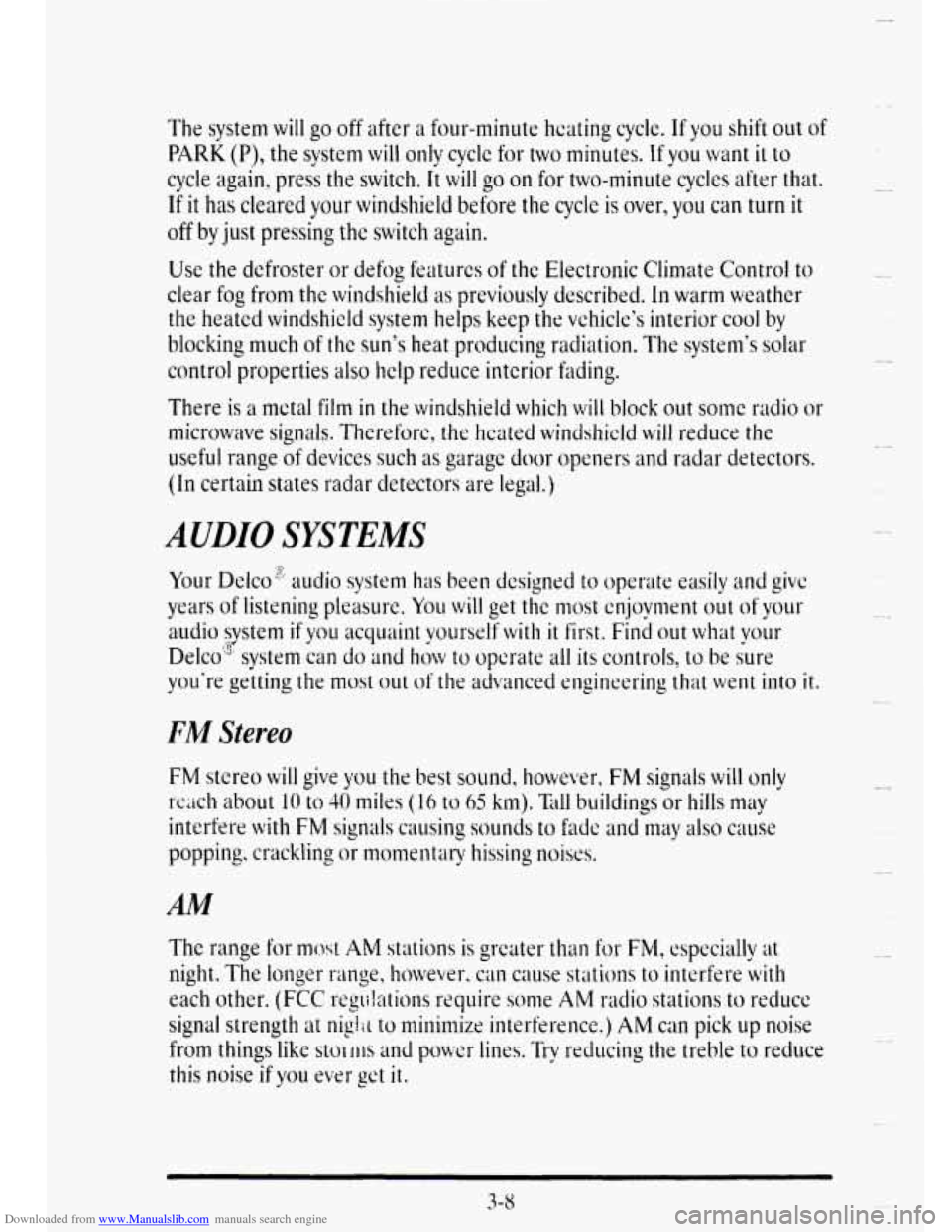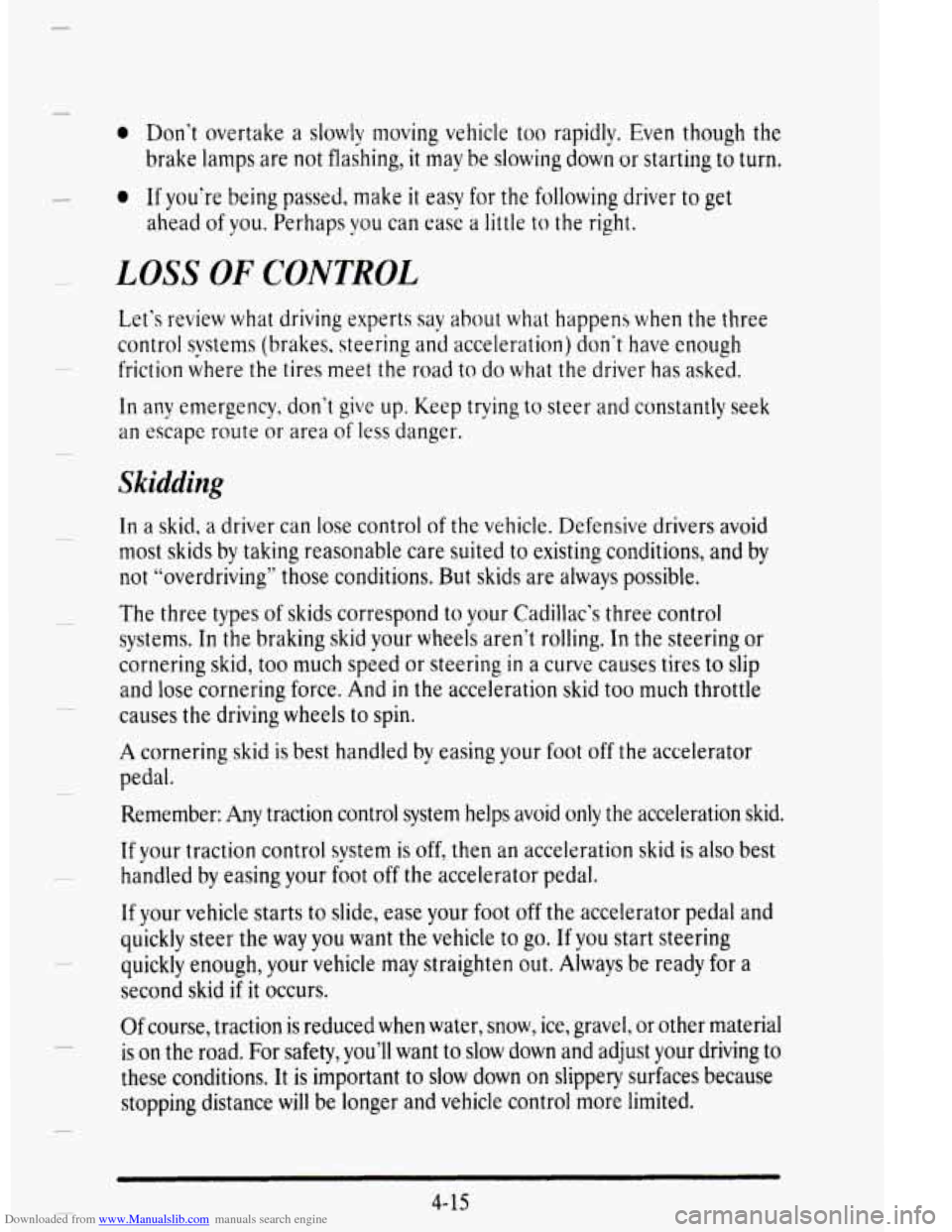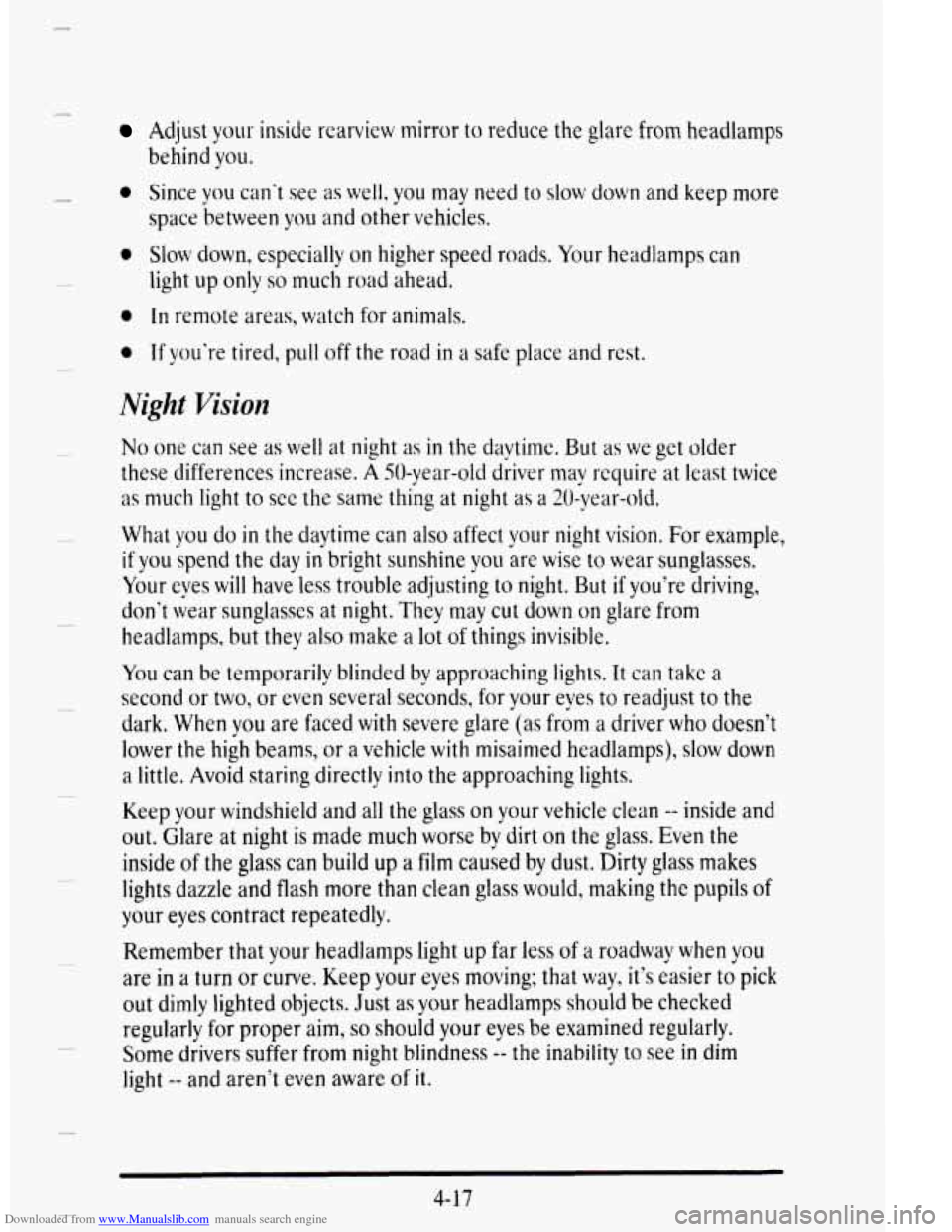ESP CADILLAC DEVILLE 1995 7.G Owners Manual
[x] Cancel search | Manufacturer: CADILLAC, Model Year: 1995, Model line: DEVILLE, Model: CADILLAC DEVILLE 1995 7.GPages: 403, PDF Size: 20.69 MB
Page 127 of 403

Downloaded from www.Manualslib.com manuals search engine Daytime Running Lamps (Canada Only)
Daytime Running Lamps (DRL) can make it easier for others to see the
front of your vehicle during the day. DRL can be helpful in many
different driving conditions,
but they can be especially helpful in the short
periods after dawn
and before sunset.
A light sensor on top of the instrument panel makes the DRL work, so be
sure it isn't covered.
The
DRL system will make your low beam headlamps come on at
reduced brightness
when:
The ignition is on
Thc headlamp switch is off, and
The transaxle is not in PARK (,P).
When it's dark enough outside, your low beam headlamps will change to
full brightness. When it's bright enough outside, the regular lamps will go
off, and your low beam headlamps change to the reduced brightness of
D RL.
To idle your vehicle with the DRL off shift the transaxle into PARK (P).
The DRL will stay off until you shift out of PARK (P).
As with anv vehicle, you should turn on the regular headlamp system
when you need it.
2-54
u
Page 168 of 403

Downloaded from www.Manualslib.com manuals search engine c
There are two things the system docsrl’r do:
It can’t sense heavy dust in the places where you drive. If you drive in a
dusty area, you should change your oil every 3,000 miles (5 000 km) or
three months (whichever comes first) unlesi the display says to change
it eve11 somer than that.
0 It doesn’t check IIOCV much oil you have, so you‘ll still have to check for
that. To see how, see “Engine Oil“ in the Index.
Electronic Level Control
The Electronic Level Control (ELC) system autonmtically adjusts the rear
trim height in response to changes in vehicle loading. The system consists
of
an air compressor assembly, air drver, exhaust solcnoici, compressor
relay, height sensor, air adjustable shocks and air tubing. The compressor
is activated
when the ignition is on and a sufficient amount of weight is
added
to the car to cause the rear suspension to deflect more than
approximately one inch. The exhaust solenoid
is powered at all times,
allowing the system to exhaust with the ignition off when excess weight
is
removed from the vehicle.
If the system has a slight leak, the air compressor will run frequently for a
few seconds each time.
For a larger air leak the air compressor may stay on for up to seven
minutes. You should see your dealer for service, but
you can keep driving
lyour Cadillac.
2-95
Page 177 of 403

Downloaded from www.Manualslib.com manuals search engine The system will go off after a four-minute heating cycle. If you shift out of
PARK (P), the system will only cyclc for two minutes. If you want it to
cycle again? press the switch. It will go on for two-minute cycles after that.
If it has cleared your windshield before the cycle is over, you can turn it
off by just pressing the switch again.
Use
the defroster or defog features of the Electronic Climate Control to
clear fog from the windshield as previously described. In warm weather
the heated windshield system helps keep the vehicle's interior cool by
blocking much of the sun's heat producing radiation. The system's solar
control properties
also help reduce intcrior fading.
There
is a metal film in the windshield which will block out some radio or
microwave signals. Therefore,
the hcated windshield will reduce the
useful range of devices such as garage door openers and radar detectors.
(In certain states radar detectors are legal.)
AUDIO SYSTEMS
Your Delco"' audio system has been designed to operate easily and give
years of listening pleasure. You will get the most cnjoyment out of your
audio system
if you acquaint vourselfwith it first. Find out what your
Delco" system can
do and f& to opcrate all its controls, to be sure
you're getting the most out of the advanced engineering cj that went into it.
-.7
H
FM Stereo
FM stereo will give you the best sound, however, FM signals will only
rclich about 10 to 40 miles ( 16 to 65 km), Ell1 buildings or hills may
interfere with
FM signals causing sounds to fade and may also cause
popping. crackling
or momentary hissing noises.
Y
AM
The range for most AM stations is greater than for FM, especially at
night. The longer
range, however, can cause stations to interfere with
each other. (FCC regdations require some AM radio stations to reduce
signal strength
at nieh to mhimize interference.) AM can pick up noise
from things like
stohs and powcr lines. Try reciucing the treble to reduce
this noise if you ever gct it.
3-8
Page 184 of 403

Downloaded from www.Manualslib.com manuals search engine 1.
c
The Lower Knob
Setting the Torte
BASS: The slide control increases 01- decreases the bass response tons.
Moving the control to thc right increases bass while moving it to the left
decreases it.
TREB: The slide control increases or decrcases the treble response tone.
Moving the control to the right increases treble while moving to the left
decreases
it.
Page 187 of 403

Downloaded from www.Manualslib.com manuals search engine The Lower Knob
Tbrn the lowcr knob to choose radio stations. Press the knob to switch
between AM and FM.
Behind the lower knob is the kdc control. It moves the sound between
the front and rear spcakcrs.
Finding a Station
SEEK: This button selects stations, but it doesn't keep moving as SCAN
does. When you press SEEK. up or down, the radio will automatically go
to the next station and stay there.
2. Tune in the station.
3. Press the SET button.
Setting the Tone
BASS: The slide control increases or decreases the bass response tone.
Moving the control
to the right increases bass while moving it tu the lct't
decreases it.
TREBLE: The slide control increascs or decreases the treble respmse
tone. Moving the control to the right increases the treble while moving it
to the left decreases it.
3-18
Page 197 of 403

Downloaded from www.Manualslib.com manuals search engine There is a gender difference, too. Women generally have a lower relative
percentage
of body water than men. Since alcohol is carried in body
water, this means that a woman generally
will reach a higher BAC level
than a man of her same
body weight when each has the same number of
drinks.
The
law in many US. states sets the legal limit at a BAC of 0.10 percent.
In a growing number of U.S. states, and throughout Canada, the limit is
0.08 percent. In some other countries it’s even lower. The BAC limit for
all commercial drivers in the US. is 0.04 percent.
The
BAC will be over 0.10 percent after three to six drinks (in one hour).
Of course, as we’ve seen, it depends on how much alcohol is in the drinks,
and
how quickly the person drinks them.
Hut the ability to drive is affected well below a BAC of 0.10 percent.
Research shows that the driving skills of
many people are impaired at a
BAC approaching 0.05 percent, and that the effects are worse at night. Ail
drivers are impaired at BAC levels above 0.05 percent. Statistics show that
the chance of being
in a collision increases sharply for drivers who have a
BAC of 0.05 percent or above. A driver with a BAC level of0.06 percent
has doubied his or her chance of having
a collision. At a BAC level of
0.10 percent, the chance of this driver having a collision is twelve times
The body takes about
an hour to rid itself of the alcohol in one drink. No
amount of coffee or number of cold showers will speed that up. “I’ll be
careful” isn’t the right answer. What
if there’s an emergency, a need to
take sudden action, as when a child darts into the street? A person with
even a moderate BAC might not be able to react quickly enough to avoid
the collision.
b oreater: at a level of 0.15 percent, the chance is twenty-five times greater!
There’s something else about drinking and driving that many people don’t
know. Medical research shows that alcohol
in a person‘s system can make
crash injuries worse, especially injuries to the brain, spinal cord or heart.
This means that when anyone
who has been drinking -- driver or
passenger
-- is in a crash, that person‘s chance of being killed or
permanently disabled is higher than if the person had not been drinking.
4-4
‘U
c
c
Page 202 of 403

Downloaded from www.Manualslib.com manuals search engine Traction Control System
c
Your vehicle has a traction control system that limits wheel spin. This is
especially useful in slippery road conditions. The system operates only if it
senses that one or both of ihc front wheels are spinning or beginning to
lose traction. When this happens, the system works the front brakes and
reduces engine power (by shutting
off fuel injectors) to limit wheel spin.
The TRACTION
ACTIVE message will display on the Driver
Information Center when the traction control
system is limiting wheel
spin. See “Driver Information Center Messages” in the Index. You may
feel the system working, or you may notice some noise, but this is normal.
If
your vehicle is in cruise control when the traction control svstem begins
to limit wheel spin, the cruise control will automatically disengage. When
road conditions
allow you to safely use it again, you may re-engage the
cruise control. (See “Cruise Control”
in the Index.)
The TRACTION DISABLED message will display on the Driver
Information Center to
let you know if there‘s a problem with your traction
control system. See “Driver Information Center Messages”
in the Index.
When this message is displaved, the system will not limit wheel spin.
Adjust your driving accordingly.
The traction control system automatically comes on whenever you start
your vehicle.
To limit wheel spin, especially in slippery road conditions,
you should always leave the svstem on. But you can turn the traction
control system
off if you ever-need to. (You should turn the system off if
your vehicle ever gets stuck in sand, mud, ice or snow. See “Rocking Your
Vehicle’’
in the Index.)
4-9
Page 207 of 403

Downloaded from www.Manualslib.com manuals search engine So here are some tips for passing:
0
0
e
e
0
e
0
"Drive ahead." Look down the road, to the sides, and to crossroads for
situations that might affect your passing patterns. If you have any
doubt whatsoever about
making a successful pass, wait for a better
time.
Watch for traffic signs, pavement markings, and lines.
if yo^ can see a
sign up ahead that might indicate a turn or an intersection, delay your
pass.
A broken center line usually indicates it's all right to pass
(providing the road ahead is clear). Never cross a solid line on your
side
of the lane or a double solid line, even if the road seems empty of
approaching traffic.
Do not get too close to the vehicle you want to pass while you're
awaiting an opportunity. For one thing, following too closely reduces
your area
of vision, especiallv if you're following a larger vehicle. Also,
you won't have adequate space if the vehicle ahead suddenly slows or
stops. Keep back
a reasonable distance.
When
it looks like a chance to pass is coming up, start to accelerate
but stay
in the right lane and don't get too close. Time your move so
you will be increasing specd as the time comes to move into the other
lane.
If the way is clear to pass, you will have a "running start" that
more than makes up
for the distance you would lose by dropping back.
And
if something happens to cause you to cancel your pass. you need
only
slow down and drop back again and wait for another opportunity
If other cars are lined up
to pass a slow vehicle, wait your turn. But
take care that someone
isn't trying c to pass you as you pull out to pass
the slow vehicle. Remember to glance over your shoulder ;ind check
the blind spot.
Check your mirrors. glancc
OVC~ your shoulder. ;~nd start your lcft 1;tnc
change signal bcfortj moving out of thc right 12111~ to pass. Whcn you
are far enough ahead of the passul vehicle to see its front in your
inside mirror, activate your right lane change signal and move back
into the right lane. (Remember that your right outside mirror is
convex. The vehicle
you just passed may seem to be farther away from
you than it really is.)
Try not to pass more than one vehicle at a time on two-lane roads.
Reconsider before passing
the next vehicle.
4-1 4
Page 208 of 403

Downloaded from www.Manualslib.com manuals search engine 0 Don't overtake a slowly moving vehicle too rapidly. Even though the
brake lamps are not flashing,
it may be slowing down or starting to turn,
0 If you're being passed, make it easv for the following driver to get
ahead
of you. Perhaps you can easi a little to the right.
LOSS OF CONTROL
Let's review what driving experts sav about what happens when the three
control svstems (brakes, steering an> acceleration)
don't have enough
friction where the tires meet the road to do what the driver has asked.
In any emergency, don't give up. Keep trying to steer and constantly seek
an escape route or area of less danger.
In a skid, a driver can lose control of the vehicle. Defensive drivers avoid
most skids
by taking reasonable care suited to existing conditions, and by
not "overdriving" those conditions.
But skids are always possible.
The three types of skids correspond to your Cadillac's three control
systems.
In the braking skid your wheels aren't rolling. In the steering or
cornering skid, too much speed or steering
in a curve causes tires to slip
and lose cornering force. And
in the acceleration skid too much throttle
causes
the driving wheels to spin.
A cornering skid is best handled by easing your foot off the accelerator
pedal.
Remember: Any traction control system helps avoid only the acceleration skid.
If your traction control system
is off? then an acceleration skid is also best
handled by easing your
foot off the accelerator pedal.
If your vehicle starts to slide, ease your foot off the accelerator pedal and
quickly steer
the way you want the vehicle to go. If you start steering
quickly enough, your vehicle may straighten out. Always be ready for a
second skid
if it occurs.
Of course, traction is reduced when water, snow, ice, gravel, or other material
is on the road. For safety, you'll want to slow down and adjust your driving to
these conditions. It is important to
slow down on slippery surfaces because
stopping distance will be longer and vehicle control more limited.
4-15
Page 210 of 403

Downloaded from www.Manualslib.com manuals search engine 0
0 0
0
Adjust your inside rearview mirror to reduce the glare from headlamps
behind you.
Since you can‘t see
as well, you may need to slow down and keep more
space between
you and other vehicles.
Slow down, especially on higher speed roads. Your headlamps can
light up only
so much road ahead.
In remote areas, watch for animals.
If you’re tired, pull off the road in a safe place and rest.
Night Vision
No one can see as well at night as in the daytime. But as we get older
these differences increase. A 50-year-old driver may require at least twice
as much light to see the same thing at night as a 20-year-old.
What
you do in the daytime can also affect your night vision. For example,
if you spend the day in bright sunshine you are wise to wear sunglasses.
Your eyes
will have less trouble adjusting to night. But if you’re driving,
don’t wear sunglasses at night. They may cut down on glare from
headlamps, but they also make a lot of things invisible.
You can be temporarily blinded
bv approaching lights. It can take a
second or two, or even several seconds, for your eves to readjust to the
dark. When
YOU are faced with severe glare (as frim a driver who doesn’t
lower the
high beams, or a vehicle with misaimed headlamps), slow down
a little. Avoid staring directly into the approaching lights.
Keep
your windshield and all the glass on your vehicle clean -- inside and
out. Glare at night is made much worse
by dirt on the glass. Even the
inside
of the glass can build up a film caused by dust. Dirty glass makes
lights dazzle and flash more than clean glass would, making the pupils of
your eyes contract repeatedly.
Remember that your headlamps light up far
less of a roadway when you
are in a turn or curve. Keep your eyes moving; that way, it’s easier to pick
out dimly lighted objects. Just as
your headlamps should be checked
regularly for proper aim,
so should your eyes be examined regularly.
Some drivers suffer
from night blindness -- the inability to see in dim
light
-- and aren’t even aware of it.
4- 3.7